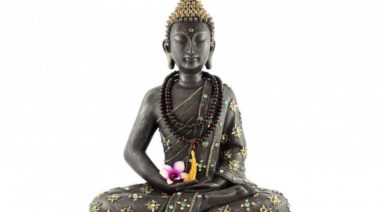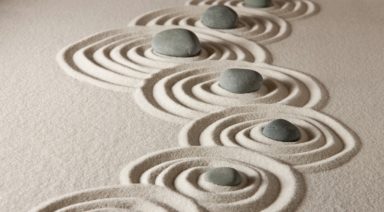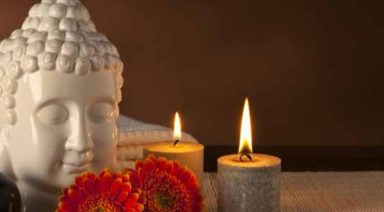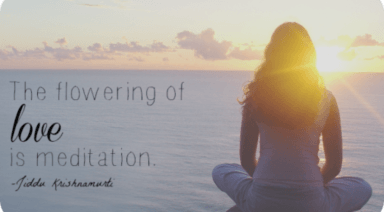How to Create a Meditation Altar

In The Miracle of Mindfulness, Zen Master Thich Nhat Hanh says that we should meditate because “each of us needs to realize total rest… mindfulness is the miracle by which we master and restore ourselves.” Sometimes even a full night of sleep doesn’t help you achieve total rest. How can the restless truly rest in modern society? Mindfulness, or the art of living in the present moment, is an important state of being to achieve in such a busy world.
Develop a Meditation Practice
As we rush through life, many of us feel like we’re not quite present in every moment. According to Karen Kissel Wegela, Ph.D., to counter this feeling, practice mindfulness meditation. Meditation allows you to let go when stressed and accept yourself just as you are – your thoughts, feelings and emotions as they arise moment to moment.
It is important to have a daily meditation practice that grounds and centers you. Such a practice will allow you to feel strongly connected to and centered with yourself. Sometimes, breathing exercises aren’t enough. You need a physical place to go to and rest. While mindfulness meditation can be practiced anywhere, it is important to have a sacred space to call your own. An altar is a beautiful space full of sacred energy that you can tap into when you need. Anyone can create an inspirational altar with just a few items and pure intention.
Watch Meditation for the Love of It
Stay Mindful When Creating Your Altar
When creating an altar, start by setting an intention, finding a space, and surrounding your space with things that are sacred to you. It really is that simple.
When setting your intention, utilize your visualization skills and write down what inspires you. Close your eyes, and let the space come to you. What do you see and feel? Even if it seems random, focus on what resonates with you. You may feel pulled to sit on a pillow by a window, and let the trees carry away your worries. Write down all that comes to you.
Choose a word for your space. Serenity. Focus. Stillness. Love. Fluidity. It can be a plain or obscure word. What does this word mean to you? Do not look up the definition. Create one. You may choose to take this word and your personal definition and craft an item to display above or on your altar. You could even create your own affirmation or mantra surrounding it.
What do you want to achieve with this space? Perhaps you want to honor your ancestors and the wisdom they bestow upon you with this altar. Choose one sentence, and let it be your affirmation of intention. Will you use this space to connect to others? Will it be for personal ritual, where you will have tools for specific rites of passage? Will it also be a family altar? This may be your personal place of solitude where you read or recite mantras. This altar may be a family altar that deepens the bond between you each.
How often will you use this space? Will it be a place that you come to daily, weekly or as you need it? Perhaps it will only be used to honor seasonal changes, major life events or holidays. Also consider its position within the house. According to the EPA, indoor air can be two to five time as polluted as outdoor air, so if you seek sunshine and fresh air, the basement isn’t your best choice.
Your Sacred Space Should Be a Place of Stillness
On your journey to find the perfect sacred space, you’ll likely want somewhere private. It can be indoors in a quiet corner of your bedroom or outdoors under a covered area or spare building. What area of your home do you feel most drawn to and relaxed within? It may be your kitchen, with the warmth of love and the smell of freshly cut herbs. Perhaps it is by your garden. Remember, your sacred space can simply be the corner of a nightstand. It’s about the energy that you’ll cultivate in the space.
The direction of the altar may be important to you to consider too. Your altar may face East, as the sun rises on a new day or a new beginning. The altar may face West, as the sun sets into a quiet night symbolizing solitude and stillness within. The direction of the altar may be aligned with certain elements as well: North as Earth, East as Air, West as Water or South as Fire. The direction of your altar does not have to be chosen. It’s about what resonates with you and why.
Altar Items Should Support and Focus Your Intention
Once you have your sacred space in mind, collect items for the altar that reinforce your intention. The key is to include items that have significant meaning for you. Perhaps the altar is draped with an old tablecloth that your grandmother hand-stitched. The item could even be a guitar pick from the show that inspired you to follow your passion for music.
Photos of family members and friends, statues of animal totems or spiritual figures, candles, particular colors, leaves or flowers could all hold a specific meaning to you. Ponder the meaning of each item as you hold it in your hands. Feel the energy of the item, as well as the wisdom. Does the message of the item support your intention?
Add tools that will assist you with making the environment perfect: incense and incense holders, crystals, drums, bells or a pillow to rest upon. Select as few or as many items as you need. Maybe most of the items are purple because that’s your favorite color. Go with it! As you decorate, your intent will flow into the space, manifesting the meditation altar you desire.
Your Altar Will Change With You
Nothing is set in stone. Remember to change up your altar. Your intention or mood will adjust. The change might be general or quite specific, depending on what is happening in your life. As you move through cycles of personal growth, your altar will reflect these changes. As loved ones pass, you may choose to mourn or honor them at your sacred space. You may celebrate births and achievements. As you celebrate the holidays or honor the seasons, your altar might reflect each of these occasions.
You may find that your altar does not serve you any longer. In place of something once elaborate, you may decide on something minimalist. Your altar may, in turn, move from a simple walk in the woods to an entire bookshelf or a developed meditation garden.
Days or months may pass where you do not use your altar – and you may even neglect it. You may find that multiple altars spring up throughout your home, even appearing on your desk at work. Who knows? Where you work could be inspired to develop their company altar or meditation room.
How frequently or infrequently that you use your altar is not as important as your awareness of your evolving meditation practice, that your altar evolves with it. Follow what resonates. Trust what you know your practice needs. Personal ritual is important to your growth, to mark your rites of passage and to see where you have been and where you are going. You can’t do that without first looking at where you are. Your altar will witness each of these places with you and it will not judge. No matter if you are crying, if you are angry, if you are joyous — this place of mindfulness is a placeholder for you to connect with your center, reinforcing your connection to others and the world in the process.
Whatever you choose to do with your altar is valid. Every altar is different and serves many purposes. This is your sacred space. There are no rules, only what you create for the reasons that are sacred to you specifically.
Honor What Speaks to You
Honor what speaks to you and speak back. Remember to speak back. Honor your voice and the wisdom you find through the use of your altar. An altar is a space than transcends multiple realms of being, the conscious and the subconscious, as well as this plane and higher planes of existence. It is a meeting ground of body, mind and spirit. It is not just a physical space with a few knick-knacks.
This sacred space is yours to do what you please with, a space to connect with yourself and to rest. Entire conversations will have taken place within you, and at first, nothing will seem to have changed. You will find that your sense of self becomes more concrete and palpable as you use your altar. Your connection to the Earth will seem to pulsate beneath your feet like blood through veins.
Listen to your instincts and respond. When you do, you are mindfully living in the moment. In turn, your life will resound with the beauty that you see in the smallest or largest of things, as well as the joys and even the sorrows. Listen to yourself, and be just as you are within your sacred space. And when you have trouble sitting still, move with Pure Love.
10 Fun Facts About Breathing & the Respiratory System

Our ability to breathe is fascinating, as it’s one of the only systems in our body that can be controlled both voluntarily, through the central nervous system, and more often involuntarily, through the autonomic nervous system. This overlap between the two systems is the reason why focused, intentional breathing methods through yoga and meditation are able to affect other involuntary muscles like the heart.
Our breath is what gives us life and without it, the human body cannot exist. But is it possible to better your life by paying more attention to how you breathe?
While breathing is so commonplace to our existence, proper breathing techniques and awareness of breath can have dramatic implications on our health. Having knowledge of specific breathing techniques can lower stress, help you sleep, help your mind function more acutely, and even curb food cravings.
When we breathe, the average adult draws in about 13 pints of air into the lungs every minute. From the lungs, that oxygen is then transferred from the air sacs in our lungs throughout the body via red blood cells to the blood vessels that distribute it to nearly every system. Meanwhile, waste gases, like CO2, are exchanged and filtered out.
For the average person with good lung health, the amount of oxygen in the blood, or the arterial blood gas (ABG) oxygen level, should be somewhere between 95-100 percent oxygen.















